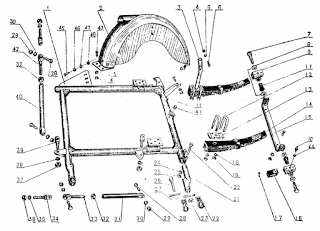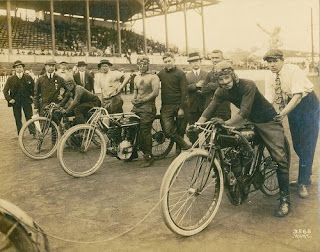“THAT GOOD GULF GASOLINE”
In the late 1930’s, my grandfather, Paul H. Logsdon,
operated a Gulf gasoline station in Munfordville, Ky. He was a part of the amazing
changing landscape that the invention of the automobile created across America.
He was one of many Americans who jumped in, rolled up their sleeves and
provided vital resources to the many travelers, business commuters, families, tourists,
and motor campers who found freedom in the power of the automobile in the first
half of the 20th century.
My grandparents in front of their GULF Super Service Station
The store window, featuring my Grandfather's name.
At the advent of the automobile, there were no fueling stations. Gasoline was available as a cleaning solvent at most drugstores and could be purchased there, but it was sold in small quantities and as there wasn’t much demand for it yet, production was fairly low, making it less than affordable. However, automobiles were outrageously expensive at that time, so if you could afford the motor car, you could afford the fuel.
A very early GULF filling station. This pre-dated my Grandfather's station. This one was located in Pennsylvania.
Thanks to Henry Ford’s Model T, the motor car became the machine of the people. Therefore, it became necessary to provide services for those people and their machines. Initially the local blacksmith became the local mechanic, and in the 19-teens they began to offer gasoline in bulk. You could drive right up and get your fuel tank filled up straight from the pump! (A novel concept at first!) Eventually, these resting, repairing, and refueling places became known as stations, much like the train station of the previous century, and the lone fortified log cabins of the century before that. A station was a place of safety and refuge for the weary traveler. A place where help could be had, provisions supplied, and preparations made for the next leg of the journey. Eventually, the term “service station” became the norm in households across the US. Though not used exclusively, a “gas station” was a place that just sold fuel. A “service station” was a place where one could find a mechanic who could do basic repairs, and usually sold tires and other parts and fluids needed to keep the motor car on the road. By the late-1920’s, the oil production companies realized that they could get their names out in front of the public and compete for brand loyalty. Branded gasoline was offered at service stations across the country. My grandfather’s first “gasoline station” was a little depression-era general store in Leitchfield, Kentucky that sold some basic refreshments, baskets, some assorted produce, and GULF brand gasoline. It was tiny and looked nothing like what you would expect a gas station to look like today, but it was his and he was proud of it. He operated it via a lease on the property and a contract with GULF.
My Grandfather's first station in Lietchfield, KY was just a general store with two pumps. It was toward the end of the Great Depression, so additional craft items were sold, including baskets, needlework, and souvenirs made from re-purposed materials.
These handsome little butterflies were made of wire, tin foil, worn out stockings, and a little paint. My Great-Great Aunt Bessie (My Grandmother's Aunt) used to make these and sell them in the general store during the Great Depression.
In the 1930’s, the oil companies came up with a plan that
would set the stage for the future of chain-operated services that are
commonplace today. The plan was to create service stations that were identical
across the nation. These bright, clean stations, located on main thoroughfares,
were easy to recognize and find. No more repurposed livery stables and
blacksmith shops! No more lone fuel pumps at the corner of the feed store or
drugstore. Now, travelers were treated to anywhere from two to four fuel pumps,
conveniently placed in front of the station on an island. The stations were usually
white with brightly colored trim to catch the eye from the road. They featured
at least two service bays where just about any work could be done. Inside the
store, patrons could find snacks, beverages, oil, maps, and many other road
necessities. There were always helpful attendants willing to pump your gas,
check your oil, of change a tube in a flash. Unlike previous stations where the
contract with the oil company was an afterthought, these stations were
purpose-built by the oil company. They would then lease the rights to the
franchise to the operator in that town. This sort of “flagship” road oasis was
known as a “Super Service Station” and they became the death knell of the “Mom-n-Pop”
general store-style stations. Knowing quality service was the key to success,
these franchises were offered first to the folks who already had contracts for
gasoline. GULF built one of their new Super Service Stations in Munfordville, just
up the road from my grandfather’s little store. When they offered him the new
franchise, he jumped at the opportunity.
The new GULF Super Service Station sat on Highway 31W in Munfordville, KY, serving customers both local and passing through. In the area before the interstate, all cross-continental travel was done on these two-lane highways.
Grandma sitting in front of the GULF Super Service Station around the eve of WWII.
Grandpa operated this franchise until he was needed for
World War Two. My grandmother recalled sitting in that station and hearing the
President give a speech on the radio on December 7th, 1941. She operated
it in his absence until the contract expired. GULF refused to renew the
contract, citing that they didn’t think a woman should run a service station.
After returning from his service in the Signal Corps, my grandfather began work
at General Electric along with many other former soldiers, never to return to
the service station industry.
A shipment of U.S. Army Jeeps bound for Ft. Knox stops by Grandpa's service station at the beginning of WWII.
In 2017, my uncles and I went seeking the location of the
old GULF Super Service Station, along with several other early 20th Century Logsdon family sites, and we found it! It still stands today, but not
as the flagship gem of the industry that it once was.
The little GULF Super Service Station on 31W in Munfordville, KY as it appears today.
It is remarkably small by
today’s standards. Time has marched on and now motorists fuel their automobiles
at massive convenience stores stocked with everything imaginable and usually
featuring more than a dozen pumps, but good luck finding anyone to pump your
gas or change your oil.








































































